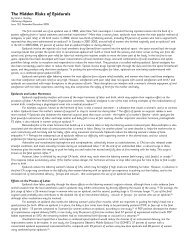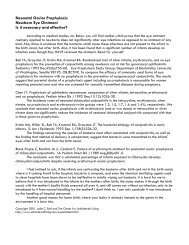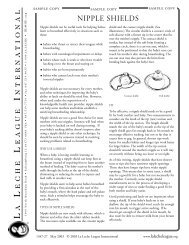Protect Your Uncircumcised Son - Balanced Birth Services
Protect Your Uncircumcised Son - Balanced Birth Services
Protect Your Uncircumcised Son - Balanced Birth Services
- No tags were found...
You also want an ePaper? Increase the reach of your titles
YUMPU automatically turns print PDFs into web optimized ePapers that Google loves.
<strong>Protect</strong> <strong>Your</strong> <strong>Uncircumcised</strong> <strong>Son</strong>: Expert Medical Advice for ParentsMothering Issue 103, November/December 103By Paul M. FleissIncreasing numbers of American parents today are protecting their sons from routinecircumcision at birth, but as their boys grow up, they often find themselves at oddswith doctors who cling to old-fashioned opinions and hospital routines.I often receive calls from distraught parents who say that a doctor insists thattheir little boy needs to be circumcised because there is something wrong. When theybring their son into my office, I almost always find that there's nothing wrong with thechild's penis. Occasionally there's a slight infection, but that can be quickly cleared upwith an antibiotic cream. In all my years of practice, I've never had a patient who hadto be circumcised for medical reasons.When a doctor advises that your son be circumcised, it's usually because he orshe is unfamiliar with the intact penis, misinformed about the true indications forsurgical amputation of the foreskin, unaware of the functions of the foreskin, anduncomfortable with the movement away from routine circumcision.Doctors can be psychologically challenged by the sight of an intact boy. Theymay see problems with the penis that do not really exist. They may try to convince youthat the natural penis is somehow difficult to care for. They may cite "studies" and"statistics" that appear to support circumcision.Probably, the only problem you will encounter with the foreskin of your intactboy is that someone will think that he has a problem. The foreskin is a perfectlynormal part of the human body, and it has very definite purposes, as do all bodyparts, even if we do not readily recognize them. There's no need to worry about yourson's intact penis.What to Say When the Doctor Says to CutBelow is a list of some of the things that doctors have said to parents in an attempt toconvince them to agree to circumcision. After each incorrect statement, I've given themedical facts to help you understand what your doctor may not know about the intactpenis and its care, and what you need to know to protect your child from unnecessarypenile surgery. If you ever find yourself in a situation where a doctor suggests thatyour child should be circumcised, the best thing that you can say is simply: "Leave italone."<strong>Your</strong> son's foreskin should be cut off in order to facilitate hygiene.My experience as a pediatrician has convinced me that circumcision makes the penisdirtier, a fact that was confirmed by a study recently published in the British Journalof Urology. 1 For at least a week after circumcision, the baby is left with a large openwound that is in almost constant contact with urine and feces--hardly a hygienicadvantage. Additionally, throughout life the circumcised penis is open and exposed todirt and contaminants of all kinds. The wrinkles and folds that often form around thecircumcision scar frequently harbor dirt and germs.Thanks to the foreskin, the intact penis is protected from dirt andcontamination. While this important protective function is extremely useful while the
aby is in diapers, the foreskin provides protection to the glans and urinary openingfor a lifetime. At all ages, the foreskin keeps the glans safe, soft, and clean.Throughout childhood, there is no need to wash underneath the foreskin.Mothers used to be advised to retract the foreskin and wash beneath it every day. Thiswas very bad advice indeed. When the foreskin becomes fully retractable, usually bythe end of puberty, your son can retract it and rinse his glans with warm water whilehe is in the shower.<strong>Your</strong> son's foreskin is too tight. It doesn't retract. He needs to be circumcised.The tightness of the foreskin is a safety mechanism that protects the glans andurethra from direct exposure to contaminants and germs. The tight foreskin also keepsthe boy's glans warm, clean, and moist, and when he is an adult, it will give himpleasure. As long as your son can urinate, he is perfectly normal. There is no age bywhich a child's foreskin must be retractable. Do not let your doctor or anyone try toretract your child's foreskin. Optimal hygiene of the penis demands that the foreskin ofinfants and children be left alone. Premature retraction rips the skin of the penis openand causes your child extreme pain. There is no legitimate medical justification forretraction. The child's discomfort is proof of that.<strong>Your</strong> son's foreskin is "adhered" to the glans. It must be amputated.The attachment of the foreskin and glans is nature's way of protecting theundeveloped glans from premature exposure. Detachment is a normal physiologicalprocess that can take up to two decades to complete. By the end of puberty, theforeskin will have detached from the glans because hormones that are produced ingreat quantities at puberty help with the process. There is no age by which a child'sforeskin must be fully separated from the glans.Some misguided doctors might suggest that the "adhesions" between theforeskin and glans should be broken so that your son can retract his foreskin. Thisprocedure is called synechotomy. To perform it, the doctor pushes a blunt metal probeunder the foreskin and forcibly rips it from the glans. It's as painful and traumatic ashaving a metal probe stuck under your fingernail to pull if off. It will also causebleeding and may result in infection and scarring of the inner lining of the foreskinand the glans. The wounds that are created by this forced separation can fusetogether, causing true adhesions. There is no medical justification for this procedurebecause the foreskin is not supposed to be separated from the glans in childhood. Ifany doctor suggests this procedure for your son, firmly refuse, stating, "Leave it alone!"<strong>Your</strong> son's foreskin is getting tighter. It no longer retracts. Something is wrong. He willhave to be circumcised.Sometimes, in childhood, a previously retractable foreskin will become resistant toretraction for reasons that are unrelated to impending puberty. In these cases, theopening of the foreskin may look chapped and sting when your son urinates. This isnot an indication for surgery any more than chapped lips. This is just the foreskindoing its job. If the foreskin were not there, the glans and urinary opening would bechapped instead. Chapping is most often caused by overly chlorinated swimmingpools, harsh soap, bubble baths, or a diet that is too high in sugar, all of whichdestroy the natural balance of skin bacteria and should be avoided if chapping occurs.
The foreskin becomes resistant to retraction until a natural and healthy bacterialbalance is reestablished.You can aid healing by having your son apply a little barrier cream or someointment to the opening of the foreskin. Acidophilus culture (which can be purchasedfrom a health food store) can be taken internally and also applied to the foreskinseveral times a day to assist healing, and should be given any time a child is takingantibiotics.<strong>Your</strong> son's foreskin is red, inflamed, itching, and uncomfortable. It has an infection andneeds to be cut off.Sometimes the tip of the foreskin does become reddened. During the diaper-wearingyears, this is usually ammoniacal dermatitis, commonly known as diaper rash. Whennormal skin bacteria and feces react with urine, they produce ammonia, which burnsthe skin and causes inflammation and discomfort. If the foreskin were amputated, theinflammation would be on the glans itself and could enter the urethra. When theforeskin becomes reddened, it is doing its job of protecting the glans and urinarymeatus.Circumcision will have no effect on diaper rash. Change your baby's diapersmore frequently and use a barrier cream until the rash clears. Harsh bath soaps canalso cause inflammation of the foreskin. Use only the gentlest and purest of soap onyour child's tender skin. Resist the temptation to give your child bubble baths,because these are harmful to the skin. Never use soap to wash the inner foreskinbecause it is mucous membrane, just like the inner lining of the eyelid.Foreskin infections are extremely rare, but if they occur, one of the many simpletreatment options is antibiotic ointment along with bacterial replacement therapy(Acidophilus culture). We don't amputate body parts because of an infection. Mostinfections of the foreskin are actually caused by washing the foreskin with soap. Leavethe foreskin alone, remembering that it doesn't need any special washing, andinfections will be unlikely to occur.<strong>Your</strong> son is always pulling on his foreskin. He should be circumcised.I can assure you that, whether circumcised or not, all little boys touch and pull ontheir penis. It is perfectly normal. Intact boys pull on the foreskin because it is there topull on. Circumcised boys pull on the glans because that is all they have to pull on.Little boys sometimes will adjust the position of their penis in their underpants. Theywill also sometimes explore the interior of the foreskin with their fingers--a perfectlynormal curiosity and nothing to worry about. It is important for parents to cultivate anenlightened and tender congeniality about such matters, otherwise they risktransferring unhealthy attitudes to their children.Sometimes a boy will pull on his foreskin because it itches. All parts of the bodyitch occasionally. Even a circumcised boy has to scratch his penis. Just as you don'tworry every time your child scratches his knee, so you should not worry when hescratches his penis. If the itch is caused by dry skin, then have your son avoid usingsoap on his penis. Treat the foreskin just as you would any other part of the body.If the real fear is of masturbation, calmly remind yourself of the simple, naturalfact that all children will explore their bodies, including their genitals. Touching theirgenitals gives children a pleasant feeling and relaxes them. Classic anatomical studies
demonstrate that the foreskin is the most pleasurably sensitive part of the penis. Youcan congratulate yourself for having protected your child from a surgical amputationthat would have permanently denied him normal sensations.<strong>Your</strong> son's foreskin is too long. It should be cut off.There is tremendous variation in foreskin length. In some boys, the foreskin representsover half the length of the penis. In others, it barely reaches the end of the glans. Allvariations are normal. The foreskin is never "just extra skin" or "redundant." It is allthere for a reason.<strong>Your</strong> child should be circumcised now because it will hurt more if it has to be done later,or worse, when he is an adult.This excuse is tragically wrong and has resulted in a very serious crisis in Americanmedical practice. It's based on the false idea that infants and young children don't feelpain. Babies can see, hear, taste, smell, and feel. In fact, babies feel pain more acutelythan adults, and the younger the baby, the more acutely the pain is felt. If an adultneeded to be circumcised, he would be given anesthesia and postoperative pain relief.Doctors almost never give babies either of these. The only reason doctors get awaywith circumcising babies without anesthesia is because the baby is defenseless andcannot protect himself. His screams of pain, terror, and agony are ignored. In anyevent, this all too common excuse is merely a scare tactic, one with tragicconsequences for any baby forced to endure a surgical amputation without the benefitof anesthesia.Since your son is having anesthesia for another operation, we'll just go ahead andcircumcise him.Most parents are never told that their son is in danger of being circumcised during atonsillectomy or surgery for a hernia or an undescended testicle. It would never occurto them. If your child is going into the hospital for any reason, be certain that you tellthe physician, surgeon, and nurse that under no circumstances is your child to becircumcised. Write "No Circumcision" on the consent form, too. Then if your child iscircumcised against your wishes, remember that you do have legal recourse.<strong>Your</strong> son has cysts under his foreskin. He needs to be circumcised.During the period when the foreskin is undergoing the slow process of detaching itselffrom the glans, sloughed skin cells (smegma) may collect into small pockets of white"pearls." These are not cysts. Some doctors mistakenly think that the smegma underthe foreskin is an infection, even though it is white rather than red, is cold to thetouch, and is painless. As the foreskin proceeds with detachment, the body will do itsjob, and these pearls will pass out of the foreskin all by themselves. These collectedpockets of cells are nothing to worry about. They are simply an indication that thenatural process of detachment is occurring.<strong>Your</strong> son has a urinary tract infection (UTI) and needs to be circumcised to prevent itfrom happening again.The belief that the foreskin slightly increases the chances of a boy having a UTI ishighly controversial and, more importantly, unproven. Members of the medical
profession in Europe do not accept it. Medical research proves that UTIs are mostoften caused by internal congenital deformities of the urinary tract. 2,3,4 The foreskinhas nothing to do with this. Even if it could be proven that circumcision slightlyreduces the risk of UTI, it is an absurd proposal because UTIs in boys are extremelyrare and are easily treated with antibiotics. Breastfeeding, too, helps prevent UTIs.Child-friendly doctors advocate breastfeeding not penile surgery.<strong>Your</strong> son sprays when he urinates. Circumcision will correct this.In almost every intact boy, the urine stream flows out of the urinary opening in theglans and through the foreskin in a neat stream. During the process of penile growthand development, some boys go through a period where the urine stream is diffused.Undoubtedly, many of these boys take great delight in this phase, while mothers,understandably, find it less amusing. If your boy has entered a spraying phase, simplyinstruct him to retract his foreskin enough to expose the meatus when he urinates. Hewill soon outgrow this phase.<strong>Your</strong> son's foreskin balloons when he urinates. He needs to be circumcised or else hewill suffer kidney damage.Ballooning of the foreskin during urination is a normal and temporary condition insome boys. It results in no discomfort and is usually a source of great delight for littleboys. Ballooning comes as a surprise only to those adults who have no experience withthis phase of penile development. It certainly does not cause kidney damage; it hasnothing to do with the kidneys. Ballooning disappears as the foreskin and glansseparate and the opening of the foreskin increases in diameter. It requires notreatment.<strong>Your</strong> son caught his foreskin in the zipper of his trousers; we will have to cut it off.There have been rare cases where a boy has accidentally caught part of the skin of hispenis in the zipper of his trousers. This is painful and can cause a lot of bleeding.Cutting off the foreskin, however, is illogical in this situation. By cutting across thebottom of the zipper with scissors, the zipper can easily be opened to release the peniletissue. Any lacerations in the skin can then be closed with either sutures or surgicaltape, depending on the situation. The proper standard of care in this situation is tominimize and repair the injury, not make it worse by cutting off the foreskin andcreating a larger and more painful surgical wound.<strong>Your</strong> son has phimosis. He needs to be circumcised to correct this problem.Phimosis is often used as a diagnosis when a doctor does not understand that thechild's foreskin is supposed to be long, narrow, attached to the glans, and resistant toretraction. Some doctors are prescribing steroid creams for phimosis, but this isunnecessary in children, since the foreskin does not need to be retractable in youngboys. The hormones of puberty will do the same thing at the appropriate time that asteroid cream is doing prematurely. In adults who still have a foreskin that is attachedto the glans or a foreskin with such a narrow opening that the glans cannot easilypass through it, steroid creams are a conservative therapy. This is if the adult wants aforeskin that fully retracts. Many males don't, preferring a foreskin that remainssecurely over the glans. It is purely a matter of personal choice, one that only each
male can decide for himself.<strong>Your</strong> son has paraphimosis and must be circumcised to prevent it from happening again.Paraphimosis is a rare dislocation of the foreskin. It is caused by the foreskin beingprematurely retracted and becoming stuck behind the glans. The dislocation can mostoften be corrected by applying firm but gentle pressure on the glans with the thumbs,as if you were pushing a cork into a bottle. To reduce the swelling, an injection ofhyaluronidase may be effective. Doctors in Britain have also reported good resultsfrom packing the penis in granulated sugar. 5 Ice packs work well, too.<strong>Your</strong> son has BXO and will have to be circumcised.Some doctors equate phimosis with an extremely rare skin disorder called balanitisxerotica obliterans (BXO), which is also called lichen sclerosus et atrophicus (LSA).BXO can appear anywhere on the body, but if this disorder affects the foreskin, it mayturn the opening of the foreskin hard, white, sclerotic, and make retraction almostimpossible. BXO is usually painless and progresses very slowly. Many times, it goesaway by itself. To an experienced dermatologist, there is no mistaking BXO, but adiagnosis must be confirmed by a biopsy. The good news is that BXO can almostalways be successfully cured with steroid creams, carbon dioxide laser treatment, oreven antibiotics. Circumcision should be considered only after every other treatmentoption has failed. Just as we do not amputate the labia of females with BXO or theglans of circumcised boys with BXO, it is logical that we should not amputate theforeskin of intact boys with BXO.<strong>Your</strong> son needs to be circumcised or else he won't enjoy oral sex as an adult.I'm afraid that doctors really have said such inappropriate things to parents. Such astatement is evidence of ignorance of the normal functions and sensations of the intactpenis. Classic anatomical investigations have proven that the foreskin is the mostrichly innervated part of the penis. It has specialized nerve receptors that are directlyconnected to the pleasure centers of the brain. <strong>Your</strong> intact son is far better equippedto enjoy all aspects of lovemaking than his circumcised peers. The myth that Americanwomen prefer the circumcised penis is, in my opinion, demeaning to women. It may betrue that American women of a certain generation and social background were morelikely to be familiar with the circumcised penis than the intact penis, but this was theresult of the mass circumcision campaigns of the 1950s not personal preference. Isuspect that what women prefer in men is more related to the personal qualities ofconsideration, gentleness, sensitivity, warmth, and supportiveness. It is very unlikelythat circumcision increases a male's capacity to develop these qualities.<strong>Your</strong> son needs to be circumcised so that he looks like his father.A child is a mixture of both his mother's and his father's genetic heritage. He doesn'tneed to look like his father, nor will he ever look like his father in every way. Eachchild is a unique gift, and that uniqueness should be cherished. The idea that a boywill be disturbed if his penis does not look like his father's was invented to manipulatepeople into letting doctors circumcise their children. It has no basis in medical fact.There are no published reports of an intact boy being disturbed because part ofhis penis was not cut off when he realized that part of his father's penis had been cut
off. When intact boys with circumcised fathers express their feelings on the matter,they consistently report their immense relief and gratitude that they were sparedpenile surgery. They express sadness, as well, for the suffering their dads experiencedas infants. 6Occasionally, a circumcised father will state that he wants his child circumcisedbecause he thinks that it will create a bond between him and his son. It is a wonderfulthing for a father to want to establish such a bond, but circumcision cannotaccomplish this worthy goal. If a father wants to establish a lasting and meaningfulbond with his son, the very best way, and perhaps the only way, he can achieve this isby spending quality time with him and by showing him much affection.Sadly, some fathers who have been circumcised have an unhealthy attitude andmay look for any excuse to schedule the child for circumcision. Putting a child in aposition where he fears that part of his penis is going to be cut off is abusive. Whenfathers demand that their sons be circumcised, I suspect that they are desperatelytrying to justify their own circumcised condition. The emotions that some fathers feelwhen they are forced to confront the fact that part of their own penis is missing can beso disturbing that they will do anything to block them out.A father who forcibly circumcises his son will not win his son's gratitude,affection, trust, or love. I am aware of instances where such events have permanentlydestroyed the father-son bond and changed a son's love for his father into rage andbitter resentment. In situations where the father suffers from an unhealthy attitudeabout his son's normal penis, I think it is best for everyone concerned--especially theson--for the father to receive compassionate psychological counseling to help himovercome his problem. All children deserve the safest, most nurturing, and most lovinghome possible.When physicians realize the important functions of the foreskin, they'll realizethat just about every problem with it can and should be solved without cutting it off.Cutting off part of the body--especially part of the penis--is an extreme measure thatshould be reserved for the most extreme of circumstances. The only legitimateindications for cutting off any part of the body, including the foreskin, are lifethreateningdisease, life-threatening deformity, or irreparable damage. Thesesituations are extremely rare.The best advice for the care of the intact penis is simply to leave it alone. Theintact penis needs no special care. Let your boy take care of it himself, and when he'sold enough, he will enjoy taking care of his own body. After all, it's his business. Justrelax and avoid worrying about your son's intact penis. Remind yourself that theforeskin is a normal and natural part of the body. If European boys grow up healthyand unconcerned with their foreskins, so can your son.NOTES1. R. S. Van Howe, "Variability in Penile Appearance and Penile Findings: A Prospective Study," British Journal of Urology 80, no.5 (November 1997): 776-782.2. J. Winberg, I. Bollgren, L. Gothefors, M. Herthelius, and K. Tullus, "The Prepuce: A Mistake of Nature?" The Lancet 8638, no. 1(March 1989): 598-599.3. S. M. Downs, "Technical Report: Urinary Tract Infections in Febrile Infants and Young Children," The Urinary TractSubcommittee of the American Academy of Pediatrics Committee on Quality Improvement, Pediatrics 103, no. 4 (April 1999): e54.4. M. A. Gill and G. E. Schutze, "Citrobacter Urinary Tract Infections in Children," Pediatric Infectious Disease Journal 18, no. 10(October 1999): 889-892.5. R. Kerwat, A. Shandall, and B. Stephenson, "Reduction of Paraphimosis with Granulated Sugar," British Journal of Urology 82,no. 5 (November 1998): 755.6. Rosemary Romberg, Circumcision: The Painful Dilemma (South Hadley, Mass.: Bergan & Garvey, 1985).
FOR MORE INFORMATIONOrganizationsIf your physician or healthcare provider ever recommends that your child be circumcised, get another opinion from a physicianwho understands the important functions of the foreskin, no matter how "urgent" the situation may be. For help finding one inyour area, contact:National Organization of Circumcision Information Resource Centers (NOCIRC). PO Box 2512, San Anselmo, CA 94979-2512.415-488-9883. Fax: 415-488-9660. www.nocirc.org/Doctors are encouraged to contact and join:Doctors Opposing Circumcision (DOC). 2442 NW Market Street #42, Seattle, WA 98107. 360-385-1882. Fax: 360-385-1948.faculty.washington.edu/gcd/DOC/Another resource especially for nurses:Nurses for the Rights of the Child. 369 Montezuma #354, Santa Fe, NM 87501. 505-989-7377. www.cirp.org/nrc/For information about alternative bris for Jewish parents:Circumcision Resource Center. Ronald Goldman, PhD. PO Box 232, Boston, MA 02133. 617-523-0088. www.circumcision.org/One of the best sources of information on the Internet:The Circumcision Information and Resource Pages. www.cirp.org/BooksDenniston, G. C., F. M. Hodges, and M. F. Milos, eds. Male and Female Circumcision: Medical, Ethical, and Legal Issues inPediatric Practice. Kluwer Academic/Plenum Press, 1999.Goldman, Ronald. Circumcision: The Hidden Trauma. Vanguard, 1996.Illingworth, Ronald S. The Normal Child: Some Problems of the Early Years and Their Treatment. Tenth edition. ChurchillLivingstone, 1991.O'Mara, Peggy, ed. Circumcision: The Rest of the Story. Mothering, 1993.Ritter, Thomas, and George C. Denniston. Say No to Circumcision! Second edition. Hourglass, 1996.Books of special interest for Jewish parents: Goldman, Ronald. Questioning Circumcision: A Jewish Perspective. Vanguard, 1997.Hoffman, Lawrence A. Covenant of Blood: Circumcision and Gender in Rabbinic Judaism. University of Chicago Press, 1996.Weiner, Kayla. Jewish Women Speak Out: Expanding the Boundaries of Psychology. Canopy Press, 1995.Important medical journal articles: DeVries, C. R., A. K. Miller, and M. G. Packer. "Reduction of Paraphimosis withHyaluronidase." Urology 48 (1996): 464-465.Fleiss, P. M., F. M. Hodges, and R. S. Van Howe. "Immunological Functions of the Human Prepuce." Sexually TransmittedInfections 74 (1998): 364-367.Jorgensen, E. T., and A. Svensson. "Problems with the Penis and Prepuce in Children: Lichen Sclerosus Should Be Treated withCoricosteroids to Reduce Need for Surgery." British Medical Journal 313 (September 14, 1996): 692.Nolan, J. F., T. J. Stillwell, and J. P. Sands, Jr. "Acute Management of the Zipper-Entrapped Penis." Journal of EmergencyMedicine 8 (1990): 305-307.Shaw, Angus. "Africa to Address AIDS at Conference." Science (September 10, 1999).Van Howe, R. S. "Circumcision and HIV Infection: Review of the Literature and Meta-analysis." International Journal of STD &AIDS 10 (1999): 8-16.Van Howe, R. S. "Does Circumcision Influence Sexually Transmitted Diseases? A Literature Review." British Journal of UrologyInternational 83, Supplement 1 (1999 ): 52-62.For more information about circumcision, see the following article in a past issue of Mothering: "The Case against Circumcision,"no. 85.Paul M. Fleiss, MD, MPH, is assistant clinical professor of pediatrics at the University of Southern California Medical Center andis in private pediatric practice in Los Angeles, California. He is the author of numerous scientific articles published in leadingnational and international medical journals.
The penis shown above is being prepared forcircumcision. In the newborn, the foreskin isattached to the glans. Tearing it away, as shown,leaves two raw, wounded surfaces.While the clitoris and glans arise fromcorresponding tissue, it does not follow that theyhave identical nerve densities. It is widely believedthat the clitoris is the erotic centre in women, butanecdotal evidence is coming in that the clitoralprepuce (the "hood") may actually be the source ofgreater stimulation. The neurology of the glanspenis and foreskin strongly suggests that this is thecase in the male.











